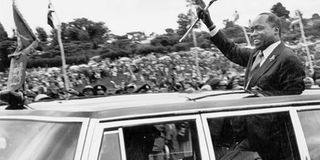How Daniel arap Moi outwitted rivals to become VP and president

Former President Daniel arap Moi greets wananchi during a rally in Kirigiti, Kiambu, on May 24, 1979. FILE PHOTO |
What you need to know:
- Mr Moi’s loyalty to President Kenyatta, who he described upon death as “my teacher, my father and my leader”, paid dividends.
- He had succeeded in the VP’s office, where two of his predecessors had failed, and was to succeed Kenyatta upon his death.
The resignation of Vice-President Joseph Murumbi in 1966 paved the way for the promotion of Daniel arap Moi, who was then Home Affairs Minister, an appointment that put him on an 11-year journey to Kenya’s most powerful job, which he was to hold onto for 24 years.
“Moi is the Man!” screamed the headline on the Daily Nation of Friday, January 6, 1967.
The announcement by President Jomo Kenyatta followed three months of anxiety during which the office was vacant after Murumbi’s resignation.
The build-up to the appointment was eventful and spectacular.
CITED HEALTH PROBLEMS
Kenyatta’s first VP, Jaramogi Oginga Odinga, quit on April 14, 1966, over ideological differences to form the opposition Kenya Peoples Union.
Joseph Murumbi, his second VP, asked to be relieved on September 20, 1966, hardly five months into office.
Although Murumbi cited health problems, he is said to have been disillusioned after the assassination of his friend, Pio Gama Pinto.
Mr Murumbi was to become chairman of Rothman Mall (K) Ltd, the short-lived tobacco firm that had entered the Kenyan market to compete with BAT.
The VP’s office had been vacant for three months, keeping everyone guessing as to who would be the man to fill it.
Speculators had a number of politicians in mind. There was Mr Paul Ngei from Ukambani, Kenyatta’s cellmate in detention.
He had just reinstated him on May 29, 1966, after his suspension following a maize scandal that plunged Kenya into hunger.
The other contenders, Mr Jackson Angaine from Meru and Mr Lawrence Sagini from Kisii, were regarded as mature politicians.
JOINED KANU
Then there was the powerful Tom Mboya, Kenyatta’s blue-eyed boy who was seen as one who could fill the void left by Jaramogi.
Others mentioned were Coast politicians Ronald Ngala and Dawson Mwanyumba and Kenyatta’s right-hand man Mbiyu Koinange.
Like Moi, Mr Ngala had joined Kanu after the opposition Kadu was disbanded.
If Kenyatta would look in the direction of Rift Valley, people thought he would pick Justus ole Tipis, a strong Kanu politician who was party treasurer at the time.
But Kenyatta sprung a surprise, going for the 42-year old Moi, who was regarded as a weak politician from a small community.
Many thought that because Moi was from a marginalised community he would be more loyal and harmless to Kenyatta. Many around the ageing Kenyatta also thought he would be easy to sideline if need be.
But though he was less opinionated, Mr Moi cleverly cut his way to the VP post and later to the presidency to earn the tag of a “passing cloud that never was.”
Indeed, it was Jaramogi himself who described Moi, in his autobiography Not Yet Uhuru, as the “giraffe with a long neck who sees far.”
And this is how Moi outwitted the rest on his way to the presidency.
STAGED RALLIES
Immediately after Kadu politicians crossed the floor in 1964, Mr Moi staged a series of rallies in Rift Valley. They were “Kenyatta and Kanu popularity” rallies in which he sent messages urging the people to support the President and Kanu.
Come the resignation of Jaramogi two years later, and Mr Moi found an avenue to endear himself to Kenyatta.
He was on the forefront of attacks against Jaramogi and his KPU, dismissing the party as “having no ideas and empty rhetoric.”
He was to tell Parliament that the resignation of Odinga and his supporters was proof “they have not been loyal to the President and the country.”
Again, he hit the road, this time around going across the country holding rallies aimed at popularising Kanu and defending Kenyatta.
EXPULSION OF FOREIGNERS
For instance, during a rally in Nakuru, he challenged perceived KPU supporters who were still in government to quit.
“Come out openly, not one by one,” he said adding: “If they lost Kanu posts it is not His Excellency’s fault, it is their own.”
Earlier in his docket as Minister for Home Affairs — which he retained — Mr Moi presided over expulsions of foreigners deemed to be working against Kenya and ordering the detention of others.
In fact, it was Mr Moi who spearheaded the passage of detention regulations in Parliament, which gave the President powers to order the detention of any person without trial.
The detention law has since been repealed.
Mr Moi’s loyalty to President Kenyatta, whom he described upon his death as “my teacher, my father and my leader”, paid dividends.
He had succeeded in the VP’s office, where two of his predecessors had failed, and was to succeed Kenyatta upon his death on August 22, 1978, and rule Kenya for 24 years.




